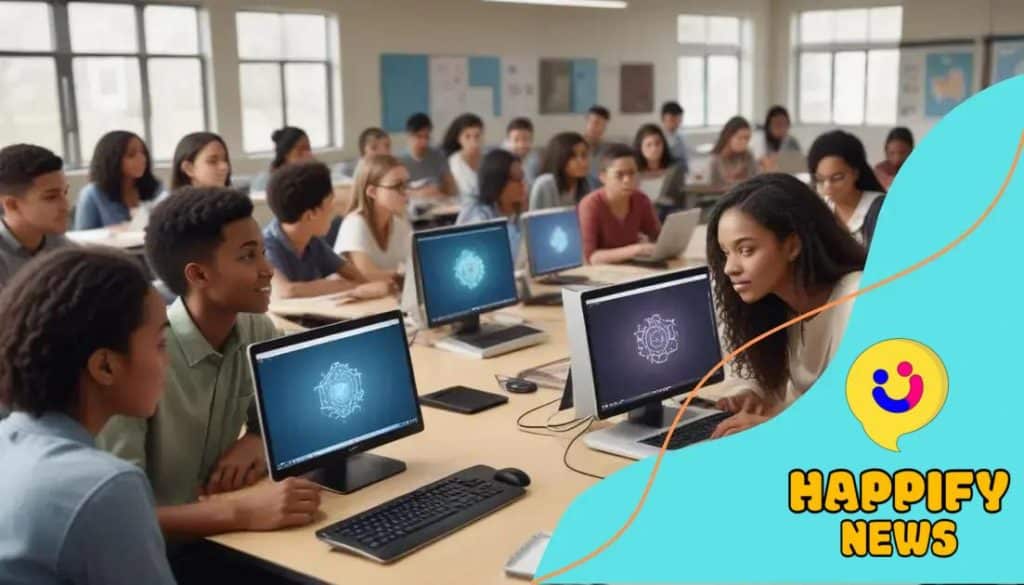AI literacy in schools: Preparing students for a smarter future

Anúncios
AI literacy in schools isn’t just a trend, it’s a necessity. In a world shaped by artificial intelligence, students must learn more than just how to use technology. They need to understand how it works, why it matters, and how it affects their lives.
This article explores how AI education can empower the next generation to thrive in a future led by intelligent systems.
Anúncios
Understanding AI literacy
Grasping AI literacy in schools begins with understanding what AI really is. It’s not just robots or sci-fi; it’s the tech behind search engines, recommendation systems, and even smart assistants. Literacy in AI means understanding these tools, not just using them.
It involves critical thinking about how AI is developed and deployed. Students learn to analyze how algorithms influence the information they receive, the products they see, and the decisions that affect them.
More than digital fluency, AI literacy promotes awareness of the ethics and responsibilities tied to data use and automation. This kind of knowledge builds conscious users, not passive consumers.
What is AI literacy?
At its core, AI literacy is the ability to understand, evaluate, and interact with AI systems. It’s about decoding how algorithms work and recognizing where AI shows up in daily life, from apps to appliances.
Anúncios
Students should learn foundational concepts like machine learning, neural networks, and algorithmic bias. This helps them engage with technology beyond the surface level.
Being AI-literate means having the tools to question, adapt, and innovate in a world driven by automated decisions and intelligent systems.
Importance of AI literacy in schools
AI literacy in schools prepares students to live and work in an AI-driven future. The sooner students gain this knowledge, the better they can adapt to rapidly evolving technologies.
It sharpens their ability to think critically and solve problems creatively. They begin to understand the broader impact of AI, from shaping job markets to influencing social norms.
Most importantly, students learn to protect their own digital identity, make informed choices, and approach new technologies with a responsible and ethical mindset.
Key components of AI literacy
Building AI literacy in schools means focusing on more than tools, it requires foundational understanding. Students should be introduced to key terms and mechanisms behind AI technologies.
Core topics include machine learning, algorithms, big data, and the social consequences of automation. These lessons open up critical conversations about privacy, bias, and fairness in digital systems.
Hands-on practice through coding, simulations, or data experiments reinforces these ideas. Real-world applications make the abstract concepts more tangible and relevant.
Benefits of AI education in schools
The benefits of AI literacy in schools go far beyond academic achievement. Teaching students how AI works empowers them to be thoughtful creators and informed decision-makers.
They learn how to examine information critically, collaborate with peers on tech-driven projects, and explore innovative solutions to real-world problems.
This kind of education gives students a competitive edge, not just in tech careers, but in any field shaped by digital transformation and data-driven decision-making.
Enhancing critical thinking skills
AI education encourages analytical thinking. Students learn to ask how AI models arrive at conclusions, helping them apply reasoning and skepticism across all subjects.
They begin to see patterns, make predictions, and test outcomes, just like scientists or engineers. These habits build mental flexibility.
By understanding how AI “thinks”, students refine their own ability to think independently, questioning assumptions and validating sources.
Fostering creativity and innovation
AI literacy in schools fuels innovation. When students understand the tools behind intelligent systems, they’re more likely to imagine creative ways to use them.
They may design apps, build chatbots, or propose solutions for global issues using AI. These projects stretch their creative boundaries.
Such experiences also highlight how AI spans across subjects, from art and music to science and social studies, making learning more connected and dynamic.
Improving digital literacy
Digital literacy deepens when AI concepts are introduced. Students gain clarity on how their data is used and what happens behind the screens.
They learn to differentiate between human and machine decisions, giving them better control over the information they consume.
This clarity leads to safer online behavior and a greater sense of responsibility in digital interactions, from social media to personal data sharing.

Challenges in implementing AI literacy
While AI literacy in schools is crucial, introducing it system-wide comes with obstacles. Many institutions are still figuring out how to bring AI education into classrooms effectively.
Budget constraints and tech disparities can limit access to AI tools and infrastructure. These gaps often reflect broader issues in education inequality.
Schools must also address curriculum design and teacher readiness. Without the right support, efforts to integrate AI concepts may fall short or leave students confused.
Limited resources
Many schools lack the financial and technical resources to support AI instruction. Not all classrooms have access to devices, software, or reliable internet.
This imbalance creates learning gaps between well-funded schools and under-resourced ones. As AI becomes essential, this digital divide must be addressed.
Partnerships with tech companies or grants for innovation can help bridge these gaps and democratize access to AI education.
Teacher training and expertise
Teachers are central to delivering AI literacy in schools, but many lack the training to teach it effectively. Few have formal education in AI-related fields.
Professional development programs, online certifications, and peer-learning communities can equip educators with the skills they need.
Support from tech specialists or guest speakers can also enrich the classroom experience and reduce the pressure on teachers to be AI experts.
Student engagement and understanding
Not all students are naturally interested in AI, and many find its concepts too abstract. Making AI relatable is essential for meaningful engagement.
Educators can connect AI to students’ lives, like how TikTok algorithms work or how smart devices make decisions. This personal relevance builds interest.
Using gamified lessons, visual tools, and creative projects can turn AI learning into something exciting and memorable for students of all backgrounds.
Effective teaching strategies for AI literacy
Effective strategies for teaching AI literacy in schools make complex topics accessible, hands-on, and collaborative. These methods spark curiosity while building technical and critical thinking skills.
Interactive learning, through coding exercises, simulations, or problem-solving, helps students absorb key concepts more naturally.
Group activities and real-world challenges also encourage teamwork, creativity, and ethical reflection. When students explore AI together, they learn faster and think deeper.
Hands-on learning experiences
Tactile learning turns theory into practice. Students learn best when they can experiment with AI tools themselves, like training simple models or exploring data patterns.
Platforms like Scratch or Teachable Machine make machine learning fun and intuitive for beginners. These tools remove the fear factor.
By building something of their own, students feel empowered and more connected to the subject matter.
Collaborative projects
Teamwork helps deepen learning and expose students to diverse perspectives. Group projects involving AI applications spark dialogue and experimentation.
Each student can take on a different role, researcher, designer, coder, depending on their interests and skills. This structure fosters inclusivity.
Through collaboration, students learn soft skills like communication and empathy, essential for working in multidisciplinary, tech-driven environments.
Using multimedia resources
Videos, simulations, and podcasts bring AI topics to life. These formats help explain abstract ideas through storytelling and visualization.
Interactive content, like AI-based quizzes or gamified lessons, keeps students engaged and motivated to learn more.
Multimedia also accommodates different learning styles, making AI education more inclusive and effective.
Role of educators in fostering AI knowledge
Teachers play a pivotal role in building AI literacy in schools. Their guidance helps students make sense of new technologies and their societal implications.
Educators must create a supportive space where exploration, inquiry, and dialogue about AI are encouraged.
They also need tools, training, and community support to bring this content into the classroom confidently and effectively.
Creating an engaging learning environment
An inspiring classroom nurtures curiosity. Teachers can create this by linking AI topics to real-world issues students care about.
When learning feels relevant, students are more likely to invest their attention and energy into understanding the subject.
Interactive discussions and project-based learning make AI education more dynamic and memorable.
Providing support and resources
Access to up-to-date resources is critical. Educators should seek out the latest teaching materials, apps, and tutorials that reflect current trends in AI.
They can also enhance learning by inviting guest speakers or arranging virtual tours of tech labs. These enrich student exposure.
With the right tools, students move from passive learners to active explorers of artificial intelligence.
Encouraging collaborative learning
Educators should facilitate teamwork around AI problems. When students learn together, they benefit from shared knowledge and diverse insights.
Guiding them through group tasks or debates helps build critical communication and thinking skills.
This kind of social learning promotes resilience, adaptability, and leadership, traits that are vital in the digital age.

The future of AI literacy in education
The future of AI literacy in schools is full of possibility. As AI becomes more embedded in society, education systems must evolve in tandem.
Forward-thinking schools are already adapting their curricula, making room for AI as a core subject. Others are just beginning the journey.
The next step is to build scalable, inclusive, and engaging AI education models that prepare every student for a tech-powered world.
Evolving curriculum to include AI
AI topics are being integrated into subjects like science, math, and even the arts. This interdisciplinary approach reflects how AI works in real life.
From ethics to engineering, students are exploring how AI intersects with global challenges and societal needs.
This evolution helps students connect their personal goals with emerging career opportunities shaped by automation and intelligent systems.
Emphasis on critical thinking
Critical thinking remains a cornerstone of AI education. Students must not only understand how AI works but also question its consequences.
They learn to explore algorithmic bias, data privacy, and the limits of machine judgment, shaping them into thoughtful tech users and creators.
Ethics-focused education ensures they use AI responsibly, not just efficiently.
Use of technology in teaching methods
Technology will play an even bigger role in how AI is taught. Virtual labs, AR simulations, and AI-driven tutoring tools will redefine the classroom.
These tools offer personalized learning experiences, adapting content to student pace and understanding.
Such innovation makes AI education more immersive, scalable, and effective, unlocking potential in every learner.
In conclusion, the future of AI literacy in education is promising. As schools adapt their curricula to include AI topics, students will be better prepared for a tech-driven world. Emphasizing critical thinking and engagement through collaborative projects will enhance understanding and spark creativity.
With the integration of technology in teaching methods and personalized learning experiences, educators will create dynamic classrooms where students can thrive. Preparing our next generation with AI skills will ensure they have the tools they need to succeed in an increasingly digital society.
FAQ – Frequently Asked Questions about AI Literacy in Education
Why is AI literacy important for students?
AI literacy is crucial as it equips students with the knowledge and skills to navigate a tech-driven world, preparing them for future careers.
What challenges do educators face in teaching AI?
Educators often struggle with limited resources, lack of training, and keeping up with the rapid changes in AI technology.
How can collaboration enhance learning in AI education?
Collaborative projects allow students to share ideas, learn from each other, and develop critical thinking skills related to AI applications.
What role does technology play in teaching AI?
Technology enhances engagement through interactive tools and resources, making learning about AI more accessible and enjoyable for students.






